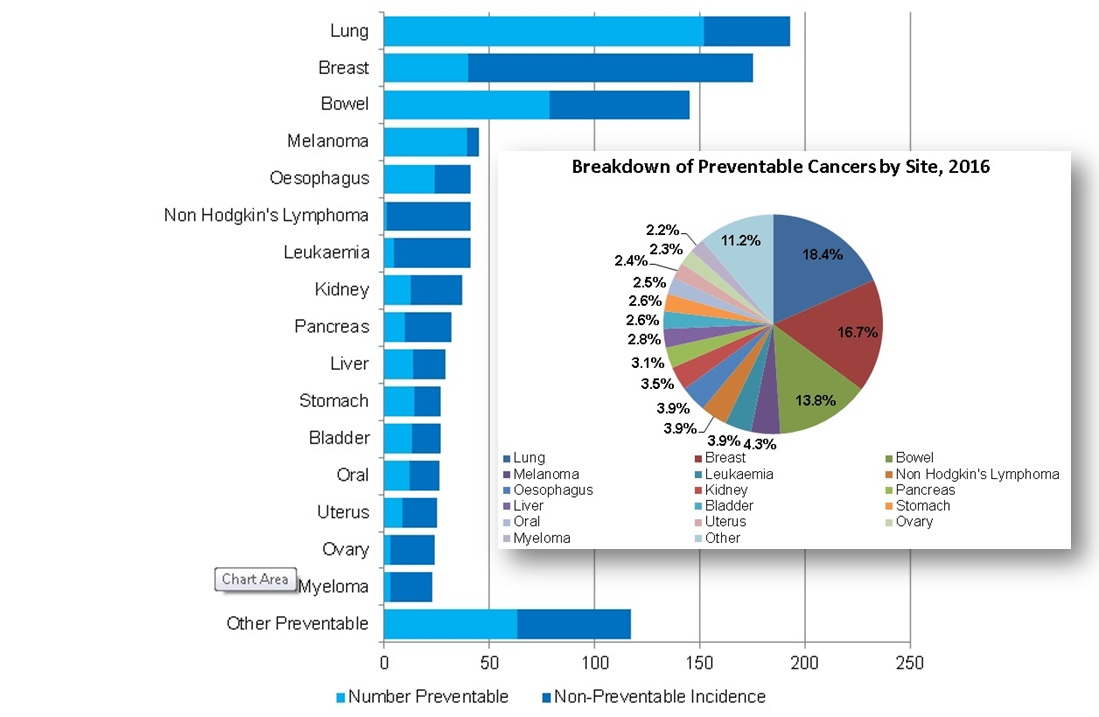
“Prevention is better than cure” is a common phrase that applies very well to cancer. A proportion of people with cancer can be cured although this often requires early detection, which is a big challenge in itself.
One of the largest reductions in cancer deaths has resulted from a prevention strategy – for example a reduction in tobacco smoking and then a reduction in lung cancer. Smoking is one of the greatest known preventable causes of cancer but in total it is thought that 40% of all cancers are preventable.
It’s clear that since more than 1 in 3 cancers are preventable, prevention is something that we should be talking about whenever cancer is mentioned and we have excellent evidence on the link between risk factors and preventable cancers.
Understanding the impact of preventable cancer at local level
In the East Midlands Cancer Research UK and Public Health England have been working together with the Cancer Alliance, and local authorities to try to do something about preventable cancer.
The aim has been to use evidence to help the local health and social care system understand the impact of preventable cancer at a local level, and then to set an ambition for addressing the risk factors that cause cancer.
One of the challenges with communication around public health is that the impact can sometimes be lost in the big numbers. A problem can seem just too big; or if only national data are available it can seem too remote – and people need to know that action to prevent cancer can be simple and effective.
In order to help people set specific ambitions to prevent cancer, we have developed data that break down the number of cancers at a local level that are caused by specific risk factors.
Data from the East Midlands
In the East Midlands, Tobacco smoke is the single biggest risk factor for cancer, followed by excess weight, poor nutrition & exposure to UV light.
We have then combined this with projections to estimate the change in the number of cases each year to 2035.
This allows us to articulate just how many cancers (of different types) are caused by which risk factors, and to estimate how many more we’d expect in 2035, by which time we’d expect to see 30% more lung cancers and 27% more breast cancers.
Across the East Midlands, we’d expect over 8,300 more cancers per year in 2035 than we had in 2016. Importantly, we can also show people how many fewer we’d expect if we did indeed prevent the preventable.
In 2035, if we did this, we would expect there to be 12,000 fewer cancers diagnosed than if no action on prevention was taken.
Using these data we have developed ‘factsheets’ for local areas containing some analysis, as well as an online tool which allows health professional to interact with the data and find the specific information about the risk factors, incidence and population that matters to them.

An example of data shown on on the fact sheet for Nottingham, displaying a breakdown of ‘Preventable’ Cancers in 2016.
We have developed this dataset for all local authorities and CCGs in England, although our published work is focused on the East Midlands at present.
Driving Action
This work is intended to provide the evidence needed to drive action to address these risk factors.
We want to enable the case for cancer prevention to be made in terms which matter locally, thus enabling action on these risk factors to be prioritised.
We know that major risk factors for cancer such as smoking and obesity are also risk factors for other significant conditions, which gives us an opportunity.
If we can combine this clear case for investing in prevention with recognition of the human cost of cancer – of the impact on all of us, the emotional cost and the personal importance of this disease – we have a powerful argument for changing priorities and increasing preventative work.
Interested in this topic? Read our blog highlighting seven things we learned from our latest cancer treatment data.

4 comments
Comment by Glenn Stewart posted on
When I go onto the developed data link it says that insufficient physical activity is not linked to any excess cancer. Is that right?
Comment by Andy Fox posted on
Hi – thanks for your comment. We think it may be the case that you haven’t selected a cancer site (such as breast) where this is a risk factor, and that the selection remained on ‘lung’, for which this isn’t a risk factor. If you try changing cancer site this should change the results.
Comment by Glenn Stewart posted on
Yes, my bad but having said that the only one that insufficient PA seems to come up on is bowel (8%) which seems to contradict Start Active Stay Active - 30% colon cancer, 20% breast comparing active to non-active people (page 12).
Presumably this is taking into account % of people who are active? But still seems odd no effect on breast cancer.
Comment by andrew duncan posted on
Hi I think most preventable risk factors are life choices? Diet, lifestyle, smoking, drug abuse? I wonder how committed the government is to actually reducing these?
Fortunately occupational exposure now much diminished; such as asbestos